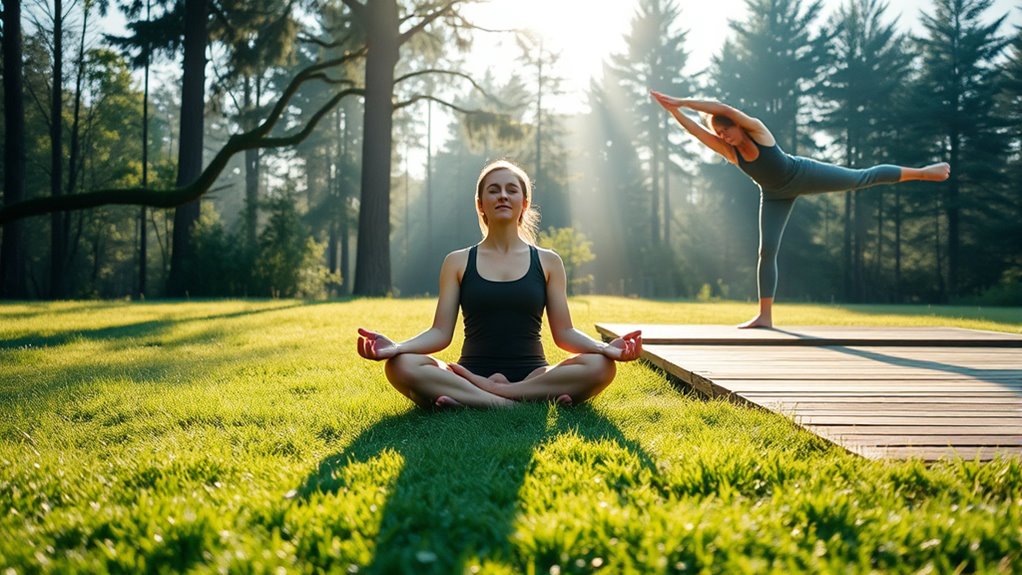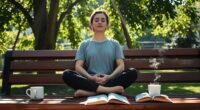Combining mindfulness with movement means you focus fully on your body, breath, and sensations during physical activity. By bringing awareness to each inhale and exhale, you make your movements more intentional and grounded in the present moment. This practice helps you notice tension, avoid injuries, and deepen relaxation. As a result, your exercise becomes more effective and enjoyable. Keep exploring how integrating mindfulness into movement can transform your routine and well-being.
Key Takeaways
- Integrating mindfulness into movement enhances presence, focus, and intentionality during physical activities.
- Breath awareness deepens body connection, calms the nervous system, and improves movement control.
- Mindful stretching and body signal awareness promote safety, flexibility, and injury prevention.
- Combining meditation with movement nurtures self-awareness, patience, and a harmonious relationship with the body.
- Practicing mindfulness during activity supports emotional well-being, mental clarity, and overall wellness.

Practicing mindfulness while moving can transform your approach to physical activity, helping you stay present and focused in the moment. When you pay close attention to your breath awareness, you tune into each inhale and exhale, grounding yourself in the here and now. This simple act of noticing your breath can deepen your connection to your body, making every movement intentional rather than automatic. As you engage in mindful stretching, you become more aware of how your muscles feel, how your joints move, and where tension resides. This awareness encourages gentle, deliberate stretches that enhance flexibility and reduce injury risk. Instead of rushing through a routine or zoning out, you focus on the sensory experience of each stretch, feeling the stretch deepen with each breath. Incorporating breath awareness into your movement practice helps you maintain a calm, centered state. With every inhale, visualize drawing in fresh energy, and with each exhale, imagine releasing tension or stress. This rhythmic breathing not only calms your nervous system but also enhances your concentration, making your movements more precise and controlled. As you perform mindful stretching, you become attuned to subtle signals from your body, like tightness or discomfort, allowing you to adjust your movements accordingly. This heightened sensitivity fosters a sense of respect for your body’s limits and promotes safer, more effective stretching sessions. Additionally, body awareness can improve your overall movement quality and reduce the likelihood of injury. You can integrate breath awareness seamlessly into your routine by pausing for a moment before each stretch to take a few deep, conscious breaths. As you stretch, maintain your focus on how your breath influences your muscle engagement, encouraging a gentle, sustained stretch rather than forcing your body. This mindful approach often reveals new sensations and insights about your physical state, which might otherwise go unnoticed. Over time, this practice deepens your self-awareness and cultivates a more compassionate, patient attitude toward your body’s needs. Mindful stretching, combined with breath awareness, also encourages a more relaxed mindset during physical activity. You learn to listen to your body’s signals rather than pushing through pain or discomfort. This awareness can translate into other forms of exercise, helping you stay present and engaged during workouts or daily movement. By integrating these mindful practices into your routine, you create a more harmonious relationship with movement—one rooted in presence, intention, and respect for your body’s wisdom. Ultimately, this approach not only improves your flexibility and strength but also nurtures your mental clarity and emotional well-being.
Frequently Asked Questions
How Quickly Can I Expect to See Benefits From Combined Mindfulness and Movement?
You can start noticing mindfulness benefits and improvements from physical activity within just a few days to weeks. Regular practice helps reduce stress, enhance mood, and boost your focus. When you combine mindfulness with movement, you may experience quicker mental clarity and physical relaxation. Consistency is key, so engaging daily or several times a week accelerates progress. Keep at it, and you’ll likely feel positive changes sooner than you expect.
Are There Specific Types of Physical Activity Better Suited for Mindfulness?
Did you know yoga increases mindfulness more than other activities? Gentle stretching and yoga poses are especially effective for mindfulness because they encourage focus on breath and body sensations. These activities promote relaxation and awareness, making it easier to stay present. Incorporating yoga into your routine can deepen your meditation practice and enhance mental clarity, offering a harmonious way to connect movement with mindfulness effortlessly.
Can Beginners Safely Practice Mindfulness During Intense Workouts?
Yes, beginners can safely practice mindfulness during intense workouts by focusing on beginner techniques that prioritize safety. Keep your awareness on your breath and body sensations, avoiding overexertion. Listen to your limits and take breaks as needed. Mindfulness safety means staying present without pushing too hard, ensuring you stay injury-free while gaining mental benefits. Start slow, build your practice, and always prioritize your well-being.
How Does Combining These Practices Impact Mental Health Long-Term?
Combining mindfulness with movement enhances your long-term mental health by boosting neuroplasticity benefits and improving emotional regulation. As you practice regularly, you’ll strengthen neural pathways, making it easier to manage stress and stay resilient. This integrated approach helps you develop greater awareness of your emotions, fostering a calmer, more balanced mindset over time. Ultimately, it supports emotional stability and cognitive flexibility, leading to sustained mental well-being.
Is There an Optimal Time of Day to Practice Mindful Movement?
You should practice mindful movement when it fits best into your daily routine, but morning or evening often work well for timing considerations. Morning sessions can energize you for the day ahead, while evening practice helps unwind and relax. Consistency matters most, so choose a time that you can stick to regularly, making it easier to enjoy the mental and physical benefits of mindfulness combined with movement.
Conclusion
By blending mindfulness with movement, you open a powerful synergy that transforms your well-being. Think of it as weaving a delicate tapestry—each mindful breath and purposeful step adding to a vibrant picture of balance and clarity. When you embrace this union, you don’t just move your body; you awaken your mind, creating a ripple of calm that extends far beyond the workout. So, step into this practice and let your inner peace flow with every motion.










